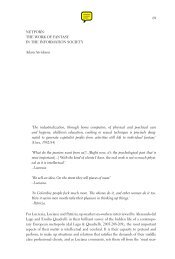Nakamura, Digitizing Race, Introduction, chapter 5, Epilogue
Nakamura, Digitizing Race, Introduction, chapter 5, Epilogue
Nakamura, Digitizing Race, Introduction, chapter 5, Epilogue
You also want an ePaper? Increase the reach of your titles
YUMPU automatically turns print PDFs into web optimized ePapers that Google loves.
<strong>Introduction</strong> 9<br />
industrial, technological, and economic forces working to deliver content<br />
via different devices and modes of viewing, has resulted in a definitive and<br />
permanent blurring between genres like film, television, virtual imaging,<br />
and writing, and that visual culture is the most appropriate modality of critique<br />
equipped to account for this melding of media that had all previously<br />
been separate. She asks: “How does the digital, an aspect of late 20th century<br />
visual culture which emerged roughly simultaneously with visual studies,<br />
figure into the field?” 12<br />
The first major book-length work that identifies itself with this orientation<br />
in an overt way is Andrew Darley’s Visual Digital Culture: Surface Play and<br />
Spectacle in New Media Genres. His critique, which is informed primarily by<br />
film history and theory, seeks to understand new media objects through their<br />
relationships to earlier types of media simulations, such as rides, amusement<br />
parks, and early film forms such as the cinema of attractions. David Bolter<br />
and Richard Grusin take a similar tack in Remediation, as does Per Persson. 13<br />
The most impressive of these is Lev Manovich, whose brilliant Language of<br />
New Media is justly credited with creating the first fully articulated theoretical<br />
work on the logic of digital media by linking the rigorous affinities between<br />
film form and history to the structure and function of computer software and<br />
its operations.<br />
However, while Darley, Manovich, and Persson pay close attention to<br />
the connections between old and new media forms, reception, and exhibition,<br />
none of them writes specifically about the Internet as a platform for<br />
digital visual culture. In other words, their critiques neglect the added and<br />
determinative element of networking—the facilitation of image production<br />
and sharing via linked computers. They write about computer-generated<br />
images and simulations as if they were texts and technologies that address<br />
the viewer in particular ways, but assume only one viewer; and when interactivity<br />
is discussed, it is in reference to the interface itself, rather than<br />
with other users. In other words, these critics write about digital visuality as if<br />
it were a medium like radio, television, or film, rather than as a mode of communication,<br />
like the telephone or the telegraph. This tendency of visual<br />
culture to omit considerations of the realm of communication, focusing instead<br />
on representations and signification that occur between a visual medium<br />
and a viewer, can be traced to its roots in the critical humanities. To use an<br />
acronym borrowed from the language of communication scholars, visualculture-oriented<br />
analyses of digital culture concern themselves with HCI<br />
(human-computer interaction) rather than CMC (computer-mediated communication).<br />
This accounts for the lack of scholarship on digital visual culture





